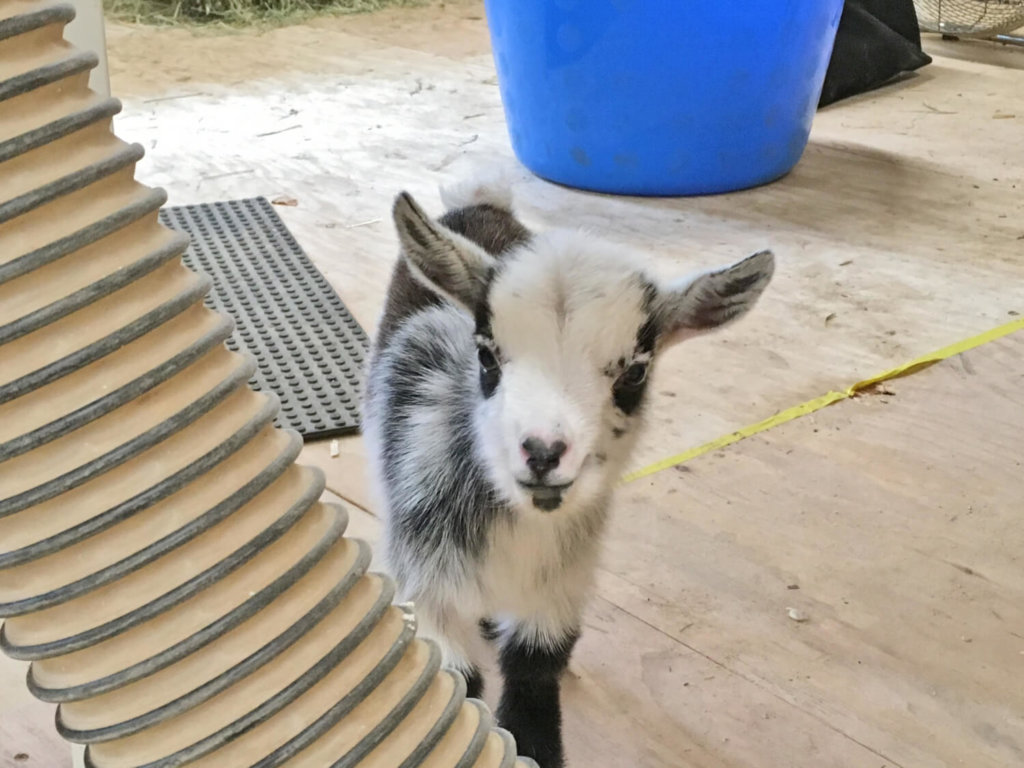Sign of spring

New life is everywhere. Sometimes we have to slow down to see it: snow fleas bounding across the dirty-white canvas of melting snow or hepatica leaves peeking from beneath leaf litter. Other signs of spring are so energetic they are impossible to miss: red-winged blackbirds wrangling for territory, flocks of robins pecking for worms, cardinals brightening the woods, and peepers and wood frogs piercing the night with their love songs.
Goats in the ‘hood
In my neighborhood kids are bounding: baby Nigerian Dwarf goats that Margaret Aiken raises for their milk. “Nigerian Dwarfs are known for their friendly personalities,” says Margaret. “Their milk has an especially high butterfat content in addition to a rich and deliciously sweet flavor.”
Mother goats can have as many as four or five kids but only have two teats. “The girls are pretty polite,” Margaret says, “waiting in line for a teat, but the little boys can be pretty pushy, shoving the females aside to get ahead.” Hmmmmmm…..
What will become of these frisky, hyper-energetic little kids? “I will keep some of the females for milk and to produce babies in future years,” Margaret says. “Other females will be sold for their milk. I will sell the neutered males as pets.” A goat for a pet? I imagine cartoons of goats ripping shirts off the clothesline and rummaging through trash cans.
“The breed is very gentle,” Margaret says. “If the kids grow up with frequent human contact, they will be excellent pets and easy to milk.” What do they eat? “The moms get grain in their final month of pregnancy and while they are producing milk,” Margaret says. “Otherwise, they are browsers, not grazers, so they eat brush rather than grass. They love poison ivy!”
In my book this is the best possible reason to own a pet goat.
Vernal pool update
On a frigid day in early March it was nearly impossible to locate “our” vernal pool, the one that a team of Charlotters is monitoring. The pool was invisible beneath a thick blanket of snow. But one warm and rainy day can make a world of difference at this time of year. A mere week later, not only was the depression that hosts the vernal pool visible but open water ringed a small part of it. That same week, monitors in Massachusetts had observed some salamanders sunning themselves on bare south-facing hillsides, even as snow covered most of the ground. We found no sunbathing salamanders in Charlotte.
We mounted an acoustic monitor on a tree that will record the mating songs and croaks of amphibians in coming weeks. The recorder is programmed to record for 10 minutes each evening at 8 p.m., 9 p.m. and 10 p.m. On future visits we will measure the percentage of ice and open water and soon thereafter egg masses from frogs and salamanders. With any luck we will be able to identify the eggs as they develop in coming weeks.
Early sunbathers
In a more normal month of March—when it’s warmer than 2019—mourning cloak butterflies flutter around Chittenden County on sunny days. Their dark brown wings, the color of mourners’ clothes, are ringed with iridescent blue spots and a white border. These early spring butterflies have not recently emerged from a chrysalis but have overwintered as adults in cracks and crevices of tree bark.
Mourning cloaks bring specific adaptations to their winter survival: antifreeze-like chemicals, glycerols, in their blood, and isometric shivering that raises body temperature to 15 or more degrees above ambient temperatures. This allows mourning cloaks to emerge on sunny days. As their wings warm in the sunshine they feed on any available tree sap and then perch in a sunny spot to look for a passing mate! Keep an eye out for these brown-winged harbingers of spring!
Meanwhile, happy early spring!

